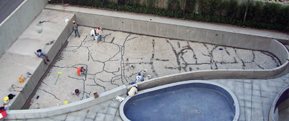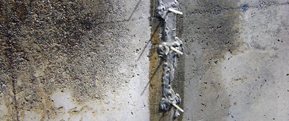Category
- Concrete Leak Repair
If you’ve followed the necessary steps to prevent cracks from forming in concrete structures and how to control them and are unsuccessful, you may be faced with a leak that requires repair. The most common method is to inject a product into the crack in an attempt to fill it and make the crack waterproof.
Typically, a series of holes are drilled along the crack length so that they intersect the crack beneath the surface. A port is then inserted into each hole and a product is pumped into the crack. Common products include slurry mixtures of cement and/or clay with water, which can be cost effective for situations of minimal water flow and low-pressure.
For more challenging repairs, hydrophilic urethane products are recommended. These react with water to produce a foam that quickly sets within the crack to block water flow. Urethane foam injection will normally remain flexible and tolerate a slight amount of movement in the concrete; however, this flexibility deteriorates with time.
Avoid using an injection product such as epoxy. Epoxy injection is designed and used for restoring the strength and integrity of cracked concrete structural elements. These cracks must be relatively dry for the epoxy to achieve adhesion. Epoxy will not displace or react with water and therefore is largely ineffective at waterproofing a leaking crack.
All injection products suffer from the disadvantage of being somewhat hit and miss because both the drilling of the holes and injection of the material is done blind. Although the success rate can be high, achieving 100 per cent effectiveness is extremely difficult. Due to this, waterproofing and creating a completely dry structure is equally challenging and unreliable. Attempting to re-inject missed and still leaking areas can also be very difficult.
To ensure that a leaking crack is made completely waterproof it is necessary to open it and repair it directly. Cracks can be quickly chiseled open using an electric chipping hammer. This involves chiseling the entire length of the crack to create a deep and narrow chase. The chase is then filled with hydraulic grout and preferably with a crystalline waterproofing system.
Crystalline waterproofing systems provide both a short-term physical barrier to water and long-term chemical waterproofing through the growth of pore-blocking crystals. Crystalline waterproofing is roughly equal to injection in the skill and time required, but is significantly cheaper and far more reliable. The downside of the repair method is that it is rigid and will not tolerate movement of the concrete. With quality products and proper training, even badly cracked and leaking concrete can be successfully repaired to a dusty-dry state. Because repairs are inconvenient and often expensive, your best crack repair strategy is to focus on prevention and control.
For more information see the NRMCA’s Concrete in Practice brief.






